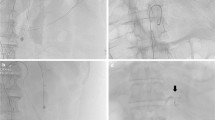Abstract
We applied multivariate analysis to the clinical findings in patients with acute gastrointestinal (GI) hemorrhage and compared the relationship between these findings and angiographic evidence of extravasation. Our study population consisted of 46 patients with acute GI bleeding. They were divided into two groups. In group 1 we retrospectively analyzed 41 angiograms obtained in 29 patients (age range, 25–91 years; average, 71 years). Their clinical findings including the shock index (SI), diastolic blood pressure, hemoglobin, platelet counts, and age, which were quantitatively analyzed. In group 2, consisting of 17 patients (age range, 21–78 years; average, 60 years), we prospectively applied statistical analysis by a logistics regression model to their clinical findings and then assessed 21 angiograms obtained in these patients to determine whether our model was useful for predicting the presence of angiographic evidence of extravasation. On 18 of 41 (43.9%) angiograms in group 1 there was evidence of extravasation; in 3 patients it was demonstrated only by selective angiography. Factors significantly associated with angiographic visualization of extravasation were the SI and patient age. For differentiation between cases with and cases without angiographic evidence of extravasation, the maximum cutoff point was between 0.51 and 0.0.53. Of the 21 angiograms obtained in group 2, 13 (61.9%) showed evidence of extravasation; in 1 patient it was demonstrated only on selective angiograms. We found that in 90% of the cases, the prospective application of our model correctly predicted the angiographically confirmed presence or absence of extravasation. We conclude that in patients with GI hemorrhage, angiographic visualization of extravasation is associated with the pre-embolization SI. Patients with a high SI value should undergo study to facilitate optimal treatment planning.
Similar content being viewed by others
References
Arber N, Tiomny E, Hallak A, et al. (1994) An eight-year experience with upper gastrointestinal bleeding: diagnosis, treatment and prognosis. J Med 25:261–269
Toyoda H, Nakano S, Takeda I, et al. (1995) Transcatheter arterial embolization for massive bleeding from duodenal ulcers not controlled by endoscopic hemostasis. Endoscopy 27:304–307
Kramer SC, et al. (2000) Embolization for gastrointestinal hemorrhages. Eur Radiol 10:802–805
Robert HB, Theodore JG, John T, Douglas T, Joseph JB. (2003) The shock index in early acute hypovolemia. Acad Emerg Med 10:494-b–495-b
Guy GE, Shetty PC, Sharma RP, Burke MW, Burke TH (1992) Acute lower gastrointestinal hemorrhage: Treatment by superselective embolization with polyvinyl alcohol particles. Am J Roentgenol 159:521–526
Gordon RL, Ahl KL, Kerlan RK, et al. (1997) Selective arterial embolization for the control of lower gastrointestinal bleeding. Am J Surg 174:24–28
Noldge G, Grosser G, Kauffmann GW, Wenz W (1982) Angiography changes after selective and superselective embolization of branches of superior mesenteric artery in small bowel. Hepatogastroenterol 29:209–212
Zuckerman DA, Bocchini TP, Birnbaum EH (1993) Massive hemorrhage in the lower gastrointestinal tract in adults: diagnostic imaging and intervention. AJR 161:703–711
Makela JT, Kiviniemi H, Laittinen S, Kairaluoma MI (1993) Diagnosis and treatment of acute lower gastrointestinal bleeding. Scand J Gastroenterol 28:1062–1066
Szold A, Katz LB, Lewis BS (1992) Surgical approach to occult gastrointestinal bleeding. Am J Surg 163:90–93
Lang EV, Picus D, Marx MV, Hicks ME (1990) Massive arterial hemorrhage from the stomach and lower esophagus: impact of embolotherapy on survival. Radiology 177:249–252
Van Beers B, Roche A (1989) L’arteriographie dans les hemorragies digestives. Acta Gastroenterol Belg 9:278–290
Sos TA, Jack GL, Wixon D, Shiderman KW (1978) Intermittent bleeding from minute to minute in acute massive gastrointestinal hemorrhage: arteriographic demonstration. Am J Roentgenol 131:1015–1017
Ljungdahl M, Eriksson L-G, Nyman R, Gustavsson S (2002) Arterial embolization in management of massive bleeding from gastric and duodenal ulcers Eur J Surg 168:384–390
Author information
Authors and Affiliations
Corresponding author
Rights and permissions
About this article
Cite this article
Nakasone, Y., Ikeda, O., Yamashita, Y. et al. Shock Index Correlates with Extravasation on Angiographs of Gastrointestinal Hemorrhage: A Logistics Regression Analysis. Cardiovasc Intervent Radiol 30, 861–865 (2007). https://doi.org/10.1007/s00270-007-9131-5
Received:
Revised:
Accepted:
Published:
Issue Date:
DOI: https://doi.org/10.1007/s00270-007-9131-5




